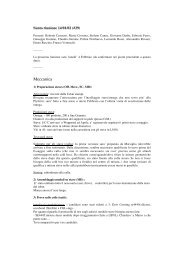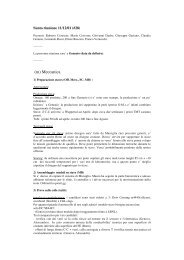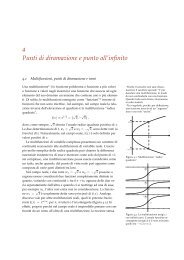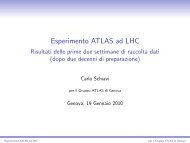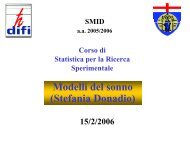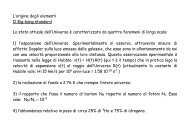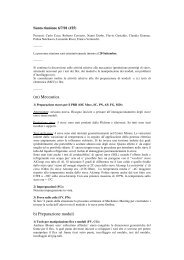Appunti di Fisica Teorica - INFN
Appunti di Fisica Teorica - INFN
Appunti di Fisica Teorica - INFN
You also want an ePaper? Increase the reach of your titles
YUMPU automatically turns print PDFs into web optimized ePapers that Google loves.
abbiamo<br />
i<br />
−<br />
e 2 θ σ2<br />
1<br />
e 2 ϑp σ3<br />
i<br />
e 2 θ σ2 =<br />
i<br />
−<br />
= e 2 θ σ2<br />
ϑp<br />
(cosh<br />
= cosh ϑp<br />
2<br />
2 + σ3 sinh ϑp<br />
2<br />
i<br />
θ σ2 ) e 2<br />
+ sinh ϑp<br />
2 (cos θ σ3 + sin θ σ1) (17.23)<br />
In conclusione i vettori <strong>di</strong> polarizzazione nella rappresentazione spinoriale<br />
(17.9) delle matrici <strong>di</strong> Dirac si scrivono<br />
u(p, σ) = √ ϑp<br />
ϑp<br />
[cosh + sinh 2 2 m<br />
(cos θ σ3 + sin θ σ1)] wσ<br />
[cosh ϑp<br />
ϑp<br />
− sinh 2 2 (cos θ σ3<br />
<br />
+ sin θ σ1)] wσ<br />
= √ ϑp<br />
ϑp p<br />
[cosh + sinh · σ] wσ<br />
2 2 |p|<br />
m<br />
[cosh ϑp<br />
<br />
ϑp p<br />
(17.24)<br />
− sinh · σ] wσ<br />
2 2 |p|<br />
Esercizio: Si verifichi che il vettore <strong>di</strong> polarizzazione (17.24) sod<strong>di</strong>sfi l’equazione<br />
<strong>di</strong> Dirac, (p µ γµ − m) u(p, σ) = 0<br />
Esercizio: Si determinino i vettori <strong>di</strong> polarizzazione<br />
<br />
u(p, σ) nella rappresen-<br />
ϑp <br />
cosh<br />
tazione standard. (Soluzione: u(p, σ) = √ m<br />
sinh ϑp<br />
2<br />
2 wσ<br />
17.1.2 Vettori <strong>di</strong> polarizzazione con elicità definita<br />
p<br />
|p|<br />
· σ wσ<br />
Sia Rˆ p (φ) una rotazione lungo l’asse ˆ p. Si ricor<strong>di</strong> che la scelta (17.7) per<br />
L(p) implica che W (R, p) = R se R è una rotazione. Pertanto, prendendo<br />
Λ = Rˆ p (φ) nella (17.5), otteniamo<br />
S(Rˆp (φ)) u(p, σ) = <br />
Dσ, σ ′(Rˆp (φ)) u(p, σ ′ ) (17.25)<br />
σ ′<br />
È possibile dunque scegliere i vettori <strong>di</strong> polarizzazione come autovettori delle<br />
rotazioni lungo l’asse ˆ p: denotiamo questi vettori — detti <strong>di</strong> elicità definita<br />
— con ũ(p, σ). Avremo:<br />
p<br />
|p| · J D ũ(p, σ) = 1<br />
σ ũ(p, σ) (17.26)<br />
2<br />
dove J D è il generatore delle rotazioni nella rappresentazione degli spinori <strong>di</strong><br />
Dirac. Poiché<br />
e −iθJy Jz e iθJy = p<br />
|p| · J (17.27)<br />
82<br />
).





